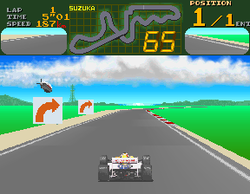Final Lap
| Final Lap | |
|---|---|
Namco System 2 |
Final Lap
Final Lap was the first racing game to allow up to eight players to simultaneously race on the Suzuka Circuit in a Formula One race. This was, at the time, considered a revolutionary feature, and was implemented by linking together up to four two-player sitdown-style arcade cabinets.
There was also a single-player mode, in which the player's
Gameplay

The player drives Formula One cars of the 1987 season and may choose between
The Famicom version is mostly unrelated to the original arcade game, including more tracks and somewhat simpler game play. The Famicom version features both a single-player and two-player split screen mode. The game uses an upgrade system, rather than different cars. The game will slowly increase the computer controlled car's difficulty, requiring the player to continuously upgrade the car in order to keep up. The upgrades consist of engine upgrades, brake upgrades, tire upgrades, and extra boost. The game was released in Japan on August 12, 1988.[3]
Reception
| Publication | Score |
|---|---|
AllGame | |
| Computer and Video Games | Positive[1] |
| Sinclair User | 9/10[5] |
| Commodore User | 5/5[6] |
This section needs expansion. You can help by adding to it. (September 2021) |
Final Lap was a major commercial success in Japan, where it remained one of the most-popular and profitable arcade games, being towards the top of arcade earnings charts for three consecutive years.[7][8][9] It was Japan's third highest-grossing arcade game of 1988 (below After Burner and Operation Wolf),[10] and went on to become Japan's highest-grossing dedicated arcade game of 1989.[11] It was later Japan's second highest-grossing dedicated arcade game of 1990 (below Super Monaco GP).[12]
The game received positive reviews from critics. Clare Edgeley of Computer and Video Games called it "a first class racing sim" that is "tremendously addictive" especially in multiplayer mode and a "definitive must" for all racing drivers.[1]
Legacy
Final Lap was followed by Final Lap 2 in 1990 which featured courses in Japan, the United States, Italy, and Monaco; Final Lap 3 in 1992, which featured courses in England, France, San Marino, and Spain; and Final Lap R in 1993, which featured courses in Belgium, Brazil, Germany, and Hungary.
There were also a number of spin-offs: a
Notes
References
- ^ a b c d e f "Arcade Action". Computer and Video Games. No. 77 (March 1988). February 1988. pp. 90–3.
- ^ Arc System Works 25th Anniversary Character Collection. ASCII Media Works. October 22, 2013. p. 246.
- ^ "Final Lap International Releases". Giant Bomb. Retrieved 2020-04-12.
- Allgame. Archived from the originalon 15 November 2014. Retrieved 14 October 2019.
- ^ "Coin Ops". Sinclair User. No. 75 (June 1988). 18 May 1988. pp. 82–3.
- ^ Kelly, Nick (May 1988). "Arcades: Final Lap". Commodore User. Archived from the original on 2 February 2019. Retrieved 13 October 2019.
- ^ "Game Machine's Best Hit Games 25 - アップライト, コックピット型TVゲーム機 (Upright/Cockpit Videos)". Game Machine (in Japanese). No. 325. Amusement Press. 1 February 1988. p. 23.
- ^ "Game Machine's Best Hit Games 25 - アップライト, コックピット型TVゲーム機 (Upright/Cockpit Videos)". Game Machine (in Japanese). No. 360. Amusement Press. July 15, 1989. p. 23.
- ^ "Game Machine's Best Hit Games 25 - アップライト, コックピット型TVゲーム機 (Upright/Cockpit Videos)". Game Machine (in Japanese). No. 368. Amusement Press. November 15, 1989. p. 23.
- ^ "Game Machine's Best Hit Games 25: '88 / "Game of the Year '88" By Game Machine" (PDF). Game Machine (in Japanese). No. 348. Amusement Press, Inc. 15 January 1989. pp. 10–1, 26.
- ^ "Videos of The Year; "Tetris", "Chase H.Q."" (PDF). Game Machine (in Japanese). No. 372. Amusement Press, Inc. 15 January 1990. p. 26.
- ^ ""Tetris" Has Still Earned More Than "Final Fight"" (PDF). Game Machine (in Japanese). No. 396. Amusement Press, Inc. 1 February 1991. p. 22.
External links
- Final Lap at the Killer List of Videogames

